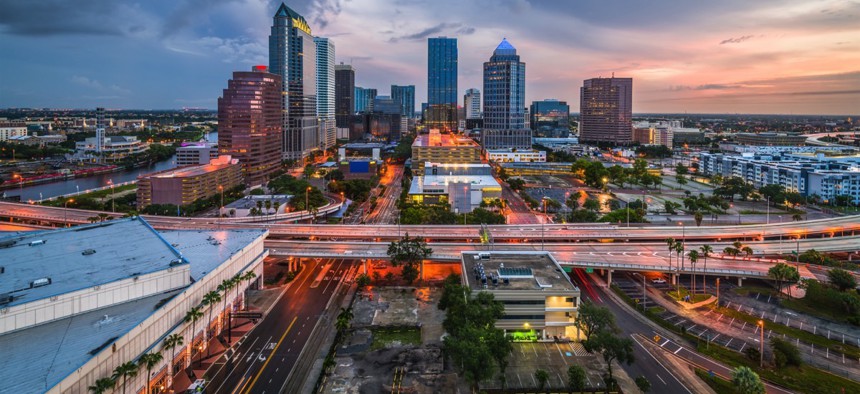Tampa’s Path to Smart City Status

Tampa, Florida
The city’s downtown will be ready for connected vehicles by 2020, and an advanced traffic management system will cover the entire city by 2023.
The Tampa Hillsborough Expressway Authority is on pace to complete a $40 million upgrade to its traffic management system that will pave the way for connected vehicles in downtown Tampa by 2020.
Earlier this year, Tampa created its Smart Mobility Division to find a way to incorporate new technologies and use data better than its legacy systems, “powered by cutting-edge ‘80s technology,” would allow, said Vik Bihde, the smart mobility manager for Tampa.
Previously the chief traffic management engineer, Bihde oversees the city’s traffic signal system, deployment of intelligent transportation systems and streetlights, as well as event traffic management.
“We need to change our mindset as … government agencies in recognizing that our roadways have shifted from brick and mortar to electrical to data infrastructure,” Bihde told Route Fifty.
In May, the new Tampa Bay Smart Cities Alliance of public, private and academic stakeholders held its first workshop to identify regional priorities: an open data platform, mobility as a service and the advanced traffic management system.
A small mobility-as-a-service pilot will test an app allowing travelers to pay for trips using the various transportation modes available in Tampa, including the Downtowner shuttle, microtransit, water taxi, and ride hailing. Residents and visitors will be able to navigate the city easier, and there’s a payoff for the city too.
“We get great data about what people are doing, rather than what people say,” Bihde said.
Hillsborough County voters in November approved a one-cent sales tax increase to fund transportation improvements, with 57 percent in favor of the initiative. The resulting funds will be spent on fiber and broadband wireless connectivity with high-resolution controllers that transmit data 10 times per second—the standard for connected vehicle infrastructure. Connected vehicles, while not necessarily autonomous, communicate with the driver, other vehicles and roadside sensors to improve efficiency and safety.
Tampa will also add cameras at intersection to not only help city staff make decisions based on what they’re seeing but employ machine-learning, so the system itself can count cars and eventually manage autonomous vehicle activity around curbsides and loading zones. During special events, Bihde wants to shift from on-street parking to ride-hailing drop-offs and pickups.
New traffic signals and streetlights will be a “microcosm” of that broader effort, Bihde said.
Tampa Electric is embarking on a 5-year, LED streetlight upgrade program approved by the Public Services Commission earlier this year. A network logic controller monitors streetlight inventory, and additional sensors can be added to them to detect gunshots or monitor empty parking—30 percent of downtown congestion during special events being caused by drivers searching for spaces.
“Five years ago we’d only be thinking about how do we optimize our signal timing, how are we responding to calls,” Bihde said.
New traffic signals are being piloted at about 40 intersections downtown, about half of them. While the connected vehicle project downtown, including performance and evaluation, will wrap in 2020, the advanced traffic management system won’t be deployed citywide until 2023.
Because Tampa is susceptible to climate change-related events, including hurricanes, the city is also exploring new ways to power its traffic lights.
Hurricane Irma was a floodless storm in Tampa, but the city still lost power for about a week—leading to economic losses and forcing police officers to do traffic control, when they were needed elsewhere after the disaster.
Solar panels that can be mounted on sidewalks are in their infancy, but if they can be developed to power signals with overnight backup and maintain surface friction for walking and biking, they could be a gamechanger, Bidhe said.
“We’re challenging the industry to come up with solutions,” he said.
Dave Nyczepir is a News Editor at Government Executive’s Route Fifty and is based in Washington, D.C.
NEXT STORY: AI to the rescue for infrastructure






